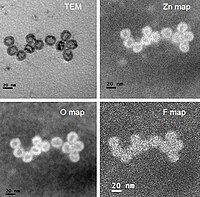
Photo from wikipedia
Abstract Photocatalytic H2 evolution, which utilizes solar energy via water splitting, is a promising route to deal with concerns about energy and environment. Herein, a direct Z-scheme TiO2/CdS binary hierarchical… Click to show full abstract
Abstract Photocatalytic H2 evolution, which utilizes solar energy via water splitting, is a promising route to deal with concerns about energy and environment. Herein, a direct Z-scheme TiO2/CdS binary hierarchical photocatalyst was fabricated via a successive ionic layer adsorption and reaction (SILAR) technique, and photocatalytic H2 production was measured afterwards. The as-prepared TiO2/CdS hybrid photocatalyst exhibited noticeably promoted photocatalytic H2-production activity of 51.4 μmol h−1. The enhancement of photocatalytic activity was ascribed to the hierarchical structure, as well as the efficient charge separation and migration from TiO2 nanosheets to CdS nanoparticles (NPs) at their tight contact interfaces. Moreover, the direct Z-scheme photocatalytic reaction mechanism was demonstrated to elucidate the improved photocatalytic performance of TiO2/CdS composite photocatalyst. The photoluminescence (PL) analysis of hydroxyl radicals were conducted to provide clues for the direct Z-scheme mechanism. This work provides a facile route for the construction of redox mediator-free Z-scheme photocatalytic system for photocatalytic water splitting.
Journal Title: Applied Surface Science
Year Published: 2017
Link to full text (if available)
Share on Social Media: Sign Up to like & get
recommendations!